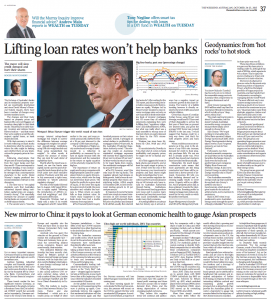Lifting loan rates won’t help banks
In this column published in The Australian, Roger explores the implications of David Murray’s Financial System Inquiry.
Click on the image below to read his piece entitled “Lifting loan rates won’t help banks”.
 You can read all of the team’s press articles through browsing our media library, view more articles here.
You can read all of the team’s press articles through browsing our media library, view more articles here.
MORE BY RogerINVEST WITH MONTGOMERY

Roger Montgomery is the Founder and Chairman of Montgomery Investment Management. Roger has over three decades of experience in funds management and related activities, including equities analysis, equity and derivatives strategy, trading and stockbroking. Prior to establishing Montgomery, Roger held positions at Ord Minnett Jardine Fleming, BT (Australia) Limited and Merrill Lynch.
He is also author of best-selling investment guide-book for the stock market, Value.able – how to value the best stocks and buy them for less than they are worth.
Roger appears regularly on television and radio, and in the press, including ABC radio and TV, The Australian and Ausbiz. View upcoming media appearances.
This post was contributed by a representative of Montgomery Investment Management Pty Limited (AFSL No. 354564). The principal purpose of this post is to provide factual information and not provide financial product advice. Additionally, the information provided is not intended to provide any recommendation or opinion about any financial product. Any commentary and statements of opinion however may contain general advice only that is prepared without taking into account your personal objectives, financial circumstances or needs. Because of this, before acting on any of the information provided, you should always consider its appropriateness in light of your personal objectives, financial circumstances and needs and should consider seeking independent advice from a financial advisor if necessary before making any decisions. This post specifically excludes personal advice.
 You can read all of the team’s press articles through browsing our media library, view more articles here.
You can read all of the team’s press articles through browsing our media library, view more articles here.
In your article you ssy’Kansas could be a long way down ‘ what is the Kansas reference
Hi Botto. here you go: https://www.youtube.com/watch?v=vQLNS3HWfCM
Banks are not indispensible…..they are a business like all businesses and the risk is could the net profit go down ?at least for a year or several? I own 3 and will reduce when i get my price….from 30% in banks to 15 -20 %
Yes, but it’ll be interesting to see if banks plunging prices will last. Lots of baby boomers retiring all at once searching for yield stocks? The banks are still pretty solid stocks, perhaps even more so now and in somewhat of a monopolistic position. This will translate into upward pressure on price. I agree with you that their near to medium term earning outlook looks grim, but the good times will roll again – its in the demographics. In the next 10 year our population will grow to 25 to 26 million souls
This is cyclical Andrew. In 35 years time the population of Australia could be double. The banks, one suspects can be earning a lot more but more people also means more volatility too.
Most people aren’t pricing in the possibility that the banks can go to zero. They probably won’t but if there is a real property bubble bursting event (property prices drop 30 – 50+%) they will probably go bust and need the government to bail them out like we saw happen overseas. Even if it’s a less than 50% risk, it’s not a tiny risk. I wouldn’t touch any Australian banks with a barge pole.
Making the banks “unquestionably strong” also makes them more attractive. How many businesses can be described this way? Also, housing is not a usual product where price is completely dictated by demand/supply. There are other variables such as dirty money being washed through our property market from other countries and from within. The demise of house prices and bank share prices is too early to call, especially as banks can always morph by buying other complementary businesses and use technology to reduce costs and provide better services.
A very prescient piece of writing on the likely direction on property prices in the near future. I’m sure bank stocks will be impacted too, but there just seems so much pent up demand for ‘yield’ stocks that I cannot see bank stocks falling dramatically.
Westpac’s last capital rising was at a 37 per cent discount to the high for the year. That’s usually defined as a crash Andrew!
Hi Roger,
Interesting article, thanks.
What does the graph represent? Percentage change in loan rates?
The editors saw fit to include a share price change graph.